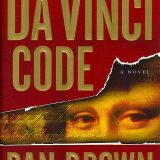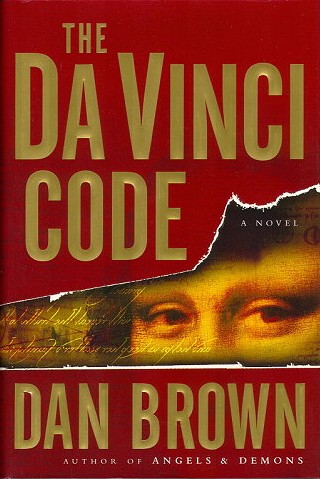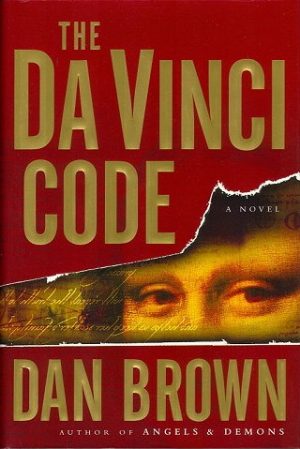The Da Vinci Code – Dan Brown – 2003
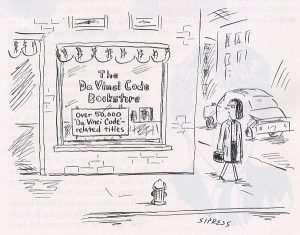
Cartoon by David Sipress, 2005 – Borrowed from The New Yorker
Da Vinci Code – Dave Barry Style
From The Miami Herald – Dave Barry – Posted on Sun, Jun. 27, 2004
‘The DaVinci Code,’ cracked
I have written a blockbuster novel. My inspiration was The DaVinci Code by Dan Brown, which has sold 253 trillion copies in hardcover because it’s such a compelling page-turner. NOBODY can put this book down:
MOTHER ON BEACH: Help! My child is being attacked by a shark!
LIFEGUARD (looking up from The DaVinci Code: Not now! I just got to page 243, where it turns out that one of the men depicted in “The Last Supper” is actually a woman!
MOTHER: I know! Isn’t that incredible? And it turns out that she’s . . .
SHARK (spitting out the child): Don’t give it away! I’m only on page 187!
The key to The DaVinci Code is that it’s filled with startling plot twists, and almost every chapter ends with a “cliffhanger,” so you have to keep reading to see what will happen. Using this formula, I wrote the following blockbuster novel, titled The Constitution Conundrum. It’s fairly short now, but when I get a huge publishing contract, I’ll flesh it out to 100,000 words by adding sentences.
CHAPTER ONE: Handsome yet unmarried historian Hugh Heckman stood in the National Archives Building in Washington, D.C., squinting through the bulletproof glass at the U.S. Constitution. Suddenly, he made an amazing discovery.
“My God!” he said, out loud. “This is incredible! Soon I will say what it is.”
CHAPTER TWO: ‘”What is it?” said a woman Heckman had never seen before who happened to be standing next to him. She was extremely beautiful, but wore glasses as a sign of intelligence.
“My name is Desiree Legume,” she said.
Heckman felt he could trust her.
“Look at this!” he said, pointing to the Constitution.
“My God, that’s incredible!” said Desiree. “It’s going to be very surprising when we finally reveal what we’re talking about!”
CHAPTER THREE: “Yes,” said Hugh, “incredible as it seems, there are extra words written in the margin of the U.S. Constitution, and nobody ever noticed them until now! They appear to be in some kind of code.”
“Let me look,” said Desiree. “In addition to being gorgeous, I am a trained codebreaker. Oh my God!”
“What is it?” asked Hugh in an excited yet concerned tone of voice. “The message,” said Desiree, “is . . . “
But just then, the chapter ended.
CHAPTER FOUR: “It’s a fiendishly clever code,” explained Desiree. “As you can see, the words say: ‘White House White House Bo Bite House, Banana Fana Fo Fite House, Fe Fi Mo Mite House, White House.’ “
“Yes,” said Hugh, frowning in bafflement. “But what can it possibly mean?”
“If I am correct,” said Desiree, “it is referring to . . . the White House!”
“My God!” said Hugh. “That’s where the president lives! Do you think . . . “
“Do I think what?” said Desiree.
“I don’t know,” said Hugh. “But we’re about to find out.”
CHAPTER FIVE: Hugh and Desiree crouched in some bushes next to the Oval Office.
“We’d better hurry up and solve this mystery,” remarked Desiree anxiously. “It’s only a matter of time before somebody notices that the Constitution is missing.” She had slipped it into her purse at the National Archives while the guard wasn’t looking.
“The answer must be here somewhere,” said Hugh, studying the ancient document, which was brown from age and the fact that he had spilled Diet Peach Snapple on it.
“Wait a minute!” he said. “I’ve got it!”
“What?” said Desiree, her breasts heaving into view.
“The answer!” said Hugh. “It’s . . .
But just then, shots rang out.
CHAPTER SIX: “That was close!” remarked Desiree. “Fortunately, those shots had nothing to do with the plot of this book.”
“Yes,” said Hugh. “Anyway, as I was saying, the answer is to hold the Constitution up so that it is aligned with the White House and the Washington Monument. . . . There, do you see what I mean?”
“My God!” said Desiree, seeing what he meant. “It’s . . . “
“Hold it right there,” said the president of the United States.
CHAPTER SEVEN: ” . . . and so you see,” concluded the president, “you two uncovered a shocking and fascinating secret that, if it should ever get out, could change the course of history.”
“Mr. President,” said Desiree, “thank you for that riveting and satisfying explanation, which will be fleshed out into much greater detail once there is a publishing contract.”
“Also,” noted Hugh, “we may use some beverage other than Snapple, depending on what kind of product-placement deals can be worked out.”
“Good,” said the president. “Now can I have the Constitution back?”
They all enjoyed a hearty laugh, for they knew that the movie rights were also available.
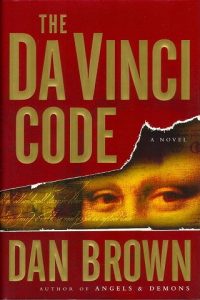
Posted by Lale on 9/7/2004, 8:14:24
Well, Dave Barry is right. So far my sentiments are: I haven’t read such trash since I was 17.
Compare this book with Glen David Gold’s Carter Beats the Devil. Carter/Devil is also a suspenseful, fun, light-weight page turner (as Da Vinci Code would wish to be), but it doesn’t insult your intelligence, it has beautiful writing, and it is funny.
When Dave Barry says in his re-enactment of the plot:
: “My God!” he said, out loud. “This is incredible!
: Soon I will say what it is.”
or
: She was extremely beautiful, but wore glasses as a
: sign of intelligence.
: “My name is Desiree Legume,” she said.
: Heckman felt he could trust her.
or
: “My God, that’s incredible!” said Desiree. “It’s
: going to be very surprising when we finally reveal what
: we’re talking about!”
He wasn’t exaggerating. The book is exactly like that.
Lale
~
Posted by Rizwan on 9/7/2004, 15:08:17
That Dave Barry essay was hilarious, Lale. Thanks for posting. Confirms my suspicions about “The DaVinci Code” and its overwhelming popularity. I don’t doubt that it’s entertaining, but now I’ll know not to believe those who also tout it as “great literature.” Yep, astounding as it may seem, I’ve been told that.
~
Posted by Meg on 9/7/2004, 23:26:07
: That Dave Barry essay was hilarious, Lale. Thanks for
: posting. Confirms my suspicions about “The
: DaVinci Code” and its overwhelming popularity. I
: don’t doubt that it’s entertaining, but now I’ll know
: not to believe those who also tout it as “great
: literature.” Yep, astounding as it may seem, I’ve
: been told that.
But on the other hand, (to tie this in with your amazing and terrifying posting about the decline of reading in America), it is quite phenomenal that this (incredibly hefty) book has drawn such (a) critical acclaim and (b) wide readership. While I have not read it, I have heard incredibly mixed reviews about it from a wide variety of people. Some loved it, some hated it…but a very large percentage of my aquaintances have read it. AND want to talk about it.
When I served on jury duty, it was kind of like being in a book club. (DC jury duty is very much hurry-up-and-wait, so we had lots of time with just the 14 of us in the juror room, and we talked about everything we could imagine.) I was reading Life of Pi and Joseph Campbell’s “Hero with a Thousand Faces” at the time, so there were a couple people who could talk about those with me. But when someone brought up Da Vinci Code, I was one of only three people in this random mix who had not read it. Everyone else thouroughly enjoyed the lively discussion.
A novel that spurs conversation and the trading of ideas between people who might not otherwise converse is a remarkable thing. And novels that spark passionate feelings — be they of disgust, (as Lale expresses) or of wonder (as my likewise articulate, well-read and discerning roomate experienced) — must have some value to it.
I worry that in our search for “great literature” we may dismiss books that are thought provoking and emotionally moving…but not quite enough. This idea has been raised a lot in our past couple discussions (which book is better, and why one does not stand up to another) and while comparative analysis is helpful and crucial to the understanding of literature, it may also serve as a barrier in a developing friendship between a reader and a novel.
~
Posted by Anna van Gelderen on 17/7/2004, 15:49:48
Just jumping in from Ecuador, without having time to read the entire discussion. I read The Da Vince Code and thought it was entertaining garbage. The so called scholarship about Jesus and so on is pure rubbish, nothing to do with scholarship at all and the holy grail is entirely an invention of the middle ages on the same par as the ring in The Lord of the Rings.
Sorry to be so outspoken, but I find it sad that when a potboiler is hailed as great literature.
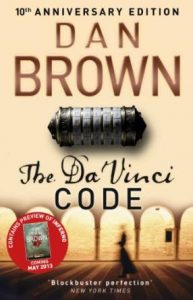
Posted by Rizwan on 19/7/2004, 14:55:15
: scholarship about Jesus and so on is pure rubbish,
: nothing to do with scholarship at all and the holy
: grail is entirely an invention of the middle ages on
: the same par as the ring in The Lord of the Rings.
On that same note, Anna:
The New York Times
Chapel Visitors Are Welcome. Just Don’t Expect the Grail.
By SARAH LYALL
Published: July 19, 2004
ROSLIN, Scotland, July 14 – People who work at Rosslyn Chapel have heard it all: how the Ark of the Covenant is concealed in a pillar; how the mummified head of John the Baptist is buried in the floor; how invisible energy lines link the chapel to the site of England’s biggest outdoor rock festival.
“I recently had a half-hour conversation with a man from the States who said he had spent some years studying how a particular carving in the chapel aligns with certain planets,” said Stuart Beattie, project director for the Rosslyn Chapel Trust. “He was very focused on the theory, though I suspect that he is the only one.”
Built in 1446, its walls and ceiling covered with hundreds of exquisite stone carvings, and rich with Christian, pagan and Masonic images, Rosslyn Chapel has always drawn legions of visitors eager to share their creative interpretations of its hidden meanings. But this summer there is a new breed of pilgrim: readers of Dan Brown’s theory-spinning “Da Vinci Code,” many of them apparently inspired by the book’s notion that the chapel hides a secret sign that, if you are very clever, can direct you to the Holy Grail itself.
These tourists have helped boost visitor numbers to the Episcopal chapel, in the rolling hills of this hamlet six miles from central Edinburgh, by 56 percent in the last month, compared with the same period last year. About 37,000 people came in 2003, and the 6,000 more so far this year appear to rest almost entirely on the runaway success of “The Da Vinci Code,” which has remained at or near the top of American best-seller lists for more than a year.
For reasons unknown to the people at Rosslyn (the chapel and the town use historically variant spellings), many of the new tourists seem not only inclined to take “The Da Vinci Code” literally, but also to have read it without proper attention to detail. It does not in fact place the Grail in the chapel, but in another secret location that the hero visits. (A hint for Grail-hunters concerned about buying plane tickets to the correct European city: Read the epilogue.)
“They come looking for the Holy Grail,” said Simon Beattie, who was selling Milky Way bars, Rosslyn Chapel plum jam and books about the Knights Templar alongside copies of “The Da Vinci Code” in the chapel gift shop the other day. “Obviously, it’s not here.”
Hannah Storie, a co-worker, said she was frequently asked about the alleged Star of David sign in the chapel floor, which Mr. Brown describes as being a crucial clue to the Grail’s whereabouts. Perhaps, persistent visitors insist, it is concealed under a carpet.
Nope, Mr. Beattie said at the gift shop. It is not under the floor, and not by the door. “We tell them that the book is a work of fiction, meaning that it isn’t true,” he said.
Visiting the chapel the other day, Anthony Lewis, a 35-year-old engineer from Bristol, England, certainly hoped it was true. What, he wasn’t sure. But something.
“I think there’s a code in there,” said Mr. Lewis, who says he believes that the Holy Grail explains the mysteries of death and is broken into small pieces that are scattered in sacred hot spots around the world. “Something is probably hidden in there somewhere, and whoever cracks the code will find it.”
Mary Fairfield, visiting from Huntington Beach, Calif., said she recently read not only “The Da Vinci Code,” but also a book positing that the Knights Templar craftily hid the Ark of the Covenant inside the chapel.
“You never know, in an old building like this, what could be buried here,” said her boyfriend, Doug Hart.
Mr. Beattie, the Rosslyn project director, is an old hand at all this. Even before the “Da Vinci Code” tourists arrived, the chapel was a magnet not only for medieval and religious historians and lovers of its extraordinary architecture, but also for a motley crowd of New Age spiritualists, Freemasons, paganists, conspiracy theorists, Knights of Templar fanatics, esoterics tracing the world’s hidden energy sources, and people intrigued by its carvings of what appears to be North American corn. Those carvings are believed to have been made, in true “Chariots of the Gods” fashion, before Columbus set sail and provide grist for a popular local theory that a Scottish nobleman traveled to Nova Scotia early in the 15th century.
“We must enjoy people’s ranging views on the chapel,” Mr. Beattie said. “We mustn’t become too eager to deflate or disabuse them of those views.” His indulgence has a hint of the mercenary since the chapel is going through a £4 million refurbishment project, and visitors pay an entrance fee of £5 (about $9). In the chapel, it seems fruitless to argue with visitors bolstered by sheets of runes, geometric diagrams, mathematical formulas, and inside information they say links Rosslyn to everything from Mary Magdalene to the planet Saturn.
“This place is a bit of a hobby of mine,” said Peter Snow, an English teacher from Edinburgh, who produced a diagram showing that a giant Star of David could plausibly be constructed by drawing imaginary lines connecting certain points in the chapel to one another. He mentioned with excitement the cavernous vault containing bodies and sacred treasures that, supposedly, exists under the chapel and has no way in and no way out.
Mr. Snow said he found some the theories in “The Da Vinci Code” intriguing and others annoying. Others take a sterner view. At the University of Edinburgh, Gary Dickson, a reader in history, said he had refused on principle to read the book, intimating that it had contributed to a situation where, as he said, “Rosslyn Chapel, one of the treasures of Pre-Reformation Scotland, has unfortunately become a Mecca for medievalizing fantasists.”
As for Mr. Beattie, he sees “The Da Vinci Code” as simply the latest in a series of books that focus attention on the chapel, and is thus inclined not to make too much of it. “I thought it was very well written,” he said, “until the end.” That part deals with Rosslyn and its link to the Grail.
Speaking of Mr. Brown, Mr. Beattie said his book seemed to end too abruptly. “It was as if he said, ‘It’s 11:30 now, and I want to go bed,’ and then just finished things up.”
~
Posted by Lale on 20/7/2004, 10:43:58
: attention to detail. It does not in fact place the
: Grail in the chapel, but in another secret location
: that the hero visits. (A hint for Grail-hunters
: concerned about buying plane tickets to the correct
: European city: Read the epilogue.)
Yeah, exactly. I am surprised people mis-read their favourite book.
The only thing they can find in that chapel is Sophie’s grandmother and brother 😉
Lale
~
Posted by Andrew Scal on 10/7/2004, 22:06:11
My soon-to-be-ex-boss has been totally enthralled by the davinci code (can’t bring myself to titlecase it). I refrained from mentioning any of the comments y’all (got that, Hanh?) have made. Nevertheless, somehow she sensed our incompatiblilty and Wednesday will be my last day of work. Next and every time I interview someone for a job it’s gonna include a discussion of literature. I somehow get the impression that aside from the stuff they made her read at college (unless she bought the M.A. and PhD.,) her last great reads were ‘Valley of the Dolls’ and ‘Coffee, Tea, or Me?’. On the other hand, she could be a secret Oprah reader (does turning the pages and sounding out the words of an Oprah’s Pick count as reading – even if you don’t move your lips while doing so?)
Andrew
~
Posted by David on 11/7/2004, 23:56:42
I just finished reading the Da Vinci Code and its Prequel Angel’s And Demons. I know they are a little less sophisticated than some of the more classical books but they were actually really entertaining. They didn’t teach me an ultimate truth or a deep philosophical meaning but I really enjoyed them. I would recommend that everyone who is a skeptic or just stubborn to read them just because Da Vinci Code got real popular or because they are really easy to break down, to just read them. Even if you don’t like them, you haven’t lost much except a week or two of reading. Angel’s and Demons, I thought was better than Da Vinci Code so I would recommend that one. Oh well, just thought I would put in my two cents about them.
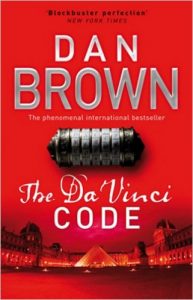
Posted by Lale on 12/7/2004, 12:30:24
Yes, Da Vinci book is entertaining. It is not a huge waste of time since it mentions many landmarks and works of art in Paris and it can be read in just a few days. The writing is just so bad though, so childish, so cliché, so banal. Anyway, I will probably finish it.
Lale
~
Posted by Lale on 11/8/2004, 10:40:15
Wrt Georges Perec’s La vie mode d’emploi (Life – A User’s Guide) and one of the hundreds of stories in it (the story of the man who bought the Vase of Passion):
This is my favourite story so far.
Just before Perec’s User Guide, the last book I read (using the term “book” loosely) was the rubbish titled Da Vinci Code. It is one of those books that is entertaining but you can’t help being annoyed at the childish style, being insulted with the stupidity you are supposed to believe and thinking you are wasting your time. You feel a little guilty. It will, however, make a fun movie, an exciting action-mystery. I wouldn’t have felt guilty watching the movie because it’s only two hours whereas the investment that goes into the book is more like 12 hours.
Anyway. Right after reading that book, I read Perec’s short story about James Sherwood who becomes the victim of a very elaborate swindling scheme and pays one million dollars to buy what he is convinced to be the Holy Grail (also the topic of Da Vinci Code). Fantastic story. Fantastic writing. Perec was a genius.


